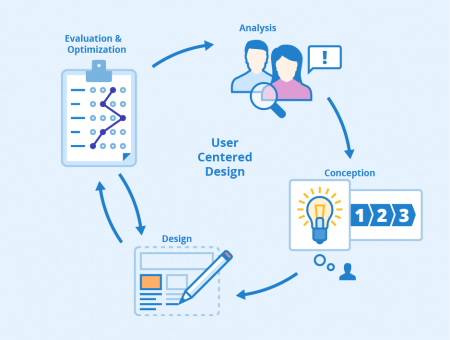User-Centered Design
Contents
Definition
User-centered design (UCD) is a product development philosophy focusing on the needs, wishes, and constraints of end-users at all stages of the design and development cycle. Products developed using the UCD method are optimized for end-users and include them in the development process. In user-centered design, it is important to understand how consumers must or want to use a product, rather than forcing them to adapt their behavior for using it.
User-centered design is a common process in software development. The international standard ISO 13407 provides the basis for UCD. This standard defines the processes during a development cycle but does not specify precise methods for user-centered design or how optimal user experience can be achieved.
Benefits of user-centered design for users and developers
The goal of UCD is to develop products that offer high degrees of usability and optimal user experience. ISO 9241-11 (1998) defines usability as the extent to which a product can be used by consumers to achieve specific goals with effectiveness, efficiency, and satisfaction in a specific context. Products designed according to the UCD philosophy enable users to meet their needs in the simplest possible way. An application's optimized usability reduces working time and improves productivity. It also leads to fewer errors that need to be corrected later.
Furthermore, products designed with UCD require less training and documentation from the publishers. Optimized usability and user experience also lead to lower fluctuation due to higher consumer satisfaction and motivation. In addition, user-centered design simplifies product maintenance and reduces the cost of future architecture redesign.
Phases of the user-centered design process

Although the fundamental principles of user-centered design are always the same and are basically an iterative development process, there are different approaches to the design process. Typical steps in designing UCD-based web applications with optimal user experience, however, are analysis, conception, implementation/design, evaluation, and optimization.
Analaysis
This phase ensures that all business and user requirements are considered before the design begins. Concrete tasks at this stage are stakeholder, user and target group analysis including the assessment of experience and skills of future users, the development of personas and the definition of user scenarios. Furthermore, the definition of usability, measurements and test goals, as well as the execution of field studies, are part of the analysis.
Concept
The conception phase of user-centered design is a synthesis phase that aims to transfer the understanding of consumers and their needs regarding user experience to the design of the user interface or website. The purpose of this phase is to define the user interaction with the future system without actually designing it. The various application scenarios that were already developed in the analysis phase are described in detail in task flows and storyboards. In addition, it is common to create wireframes as clickable prototypes that are tested by end-users to ensure that the planned application meets their requirements.
Design
In user-centered design, the design phase is not an end in itself. Rather, it should be seen as an opportunity to solve problems and ensure optimal user experience. A consistent, appealing, and clear graphic design helps to strengthen a brand, present information in a meaningful way, and improve user experience by creating an intuitive interface.
Evaluation & optimization
After the product has been created and shortly before its release, usability tests are conducted to evaluate the product's success and user experience. Success can be measured with the key performance indicator (KPI) “usability”, for example. It tests the effectiveness (i.e. how well the system enables the user to achieve his goals) and efficiency (how much effort and time is required to perform tasks). In addition, depending on the product, there are further tests that show how high user safety is, i.e. to what extent an environment including devices, software, facilities or persons is free of hazards. Last but not least, the satisfaction of consumers, their subjective perception, as well as their reactions are measured.
If the evaluation reveals defects, the design is revised accordingly and the product is re-evaluated. Once it meets requirements and quality standards, the product can be delivered. Should it turn out that the level of information is not sufficient in this respect, further analyses may have to be carried out. This procedure helps user-centered design to avoid errors that would otherwise only be discovered after the product has been delivered to the user. In this case, such problems could only be solved with considerable additional effort.
Related links
- https://usabilitygeek.com/user-centered-design-introduction/
- https://medium.theuxblog.com/my-user-centered-design-mashup-defining-process-and-communicating-value-65df72f5648a
Similar articles